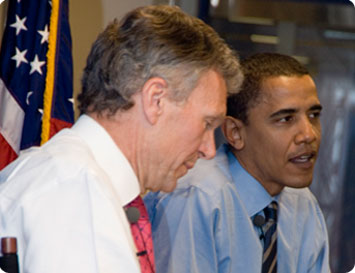So Damn Much Money, Robert G. Kaiser, 2009
A definitive history of the money driven breakdown of American government from about 1975 through the Administration of W by Robert Kaiser who has been on the staff of the Washington Post since 1963. The history focuses on the career of one of Washington’s most successful lobbyists, Gerald Cassidy, as a device to follow the changes and trends as money comes to corrupt all of Washington. Kaiser highlights the Abramoff scandal which even Washington recognized as going too far and which contributed significantly to the Republicans losing control of Congress in 2006.
Abramoff with W 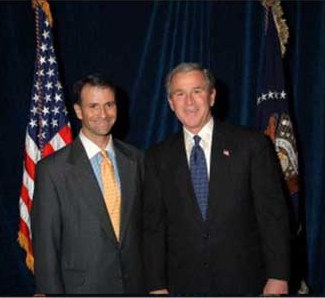
The era of the Great Society legislation of LBJ and Nixon, who is portrayed here as a progressive Republican who attempted to control runaway inflation by controlling prices (such as gasoline) and who initiated modern health care based on the Kaiser Permanente model and formed OSHA to regulate safety in the workplace. This was the era of Ralph Nader successfully suing Ford Motor and others for building dangerous products and the start of successful lawsuits against big tobacco. It was also the era of breaking up monopolies like AT&T. Washington was not business’s friend and business tried to avoid or minimize dealings with Washington.
The big insight here is the role played by the Democrats in the total breakdown of Washington. The Democrats controlled Congress uninterruptedly from 1955 to 1995 when the Gingrich revolution resulted in Republican control of both houses. Cassidy was not a conservative Republican but a Democrat who got his start in politics working for McGovern on a Great Society nutrition program. When he began his lobbying operation in 1975, it was to help Universities get much needed grants for research and other socially beneficial causes. University grants were totally under the control of a corrupt peer review process that assured that Federal grants all went to a handful of Universities. The peer recommendations were then steered through congress by the small handful of “whales” who controlled Congress. Cassidy did not invent the earmark, but he may have perfected its use to get special grants directed to his client universities (Boston College and Columbia at first) by district and state congressmen and senators. So the start of the modern lobbying industry had its origins in progressive and liberal circles for the purpose of breaking up a University grant monopoly.
Seeing Cassidy’s success on behalf of the have not Universities, corporations such as Pirelli and Ocean Spray started retaining Cassidy to seek grants of their own. The modern era of corporate sponsored lobbying had begun. Cassidy grew up a poor Irish kid who came to love the money that lobbying could produce and blind to what he was doing to earn it.
Roger Ailes 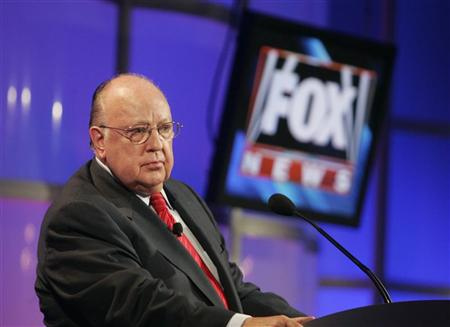
The next big change in Washington occurred when expensive television ads and negative campaigning came into its own. The big revolution happened with H.W. Bush’s 1988 campaign masterminded by Roger Ailes (founder of Fox News) and Lee Atwater. The two used TV ads to utterly destroy Dukakis in the election. The message was not lost on anyone in Washington and the cost of campaigning skyrocketed as professional opinion makers, TV ad producers, and other professionals came to Washington alongside the lobbyists to run campaigns. Campaigning became a professional, very expensive occupation. The candidates needed to spend more time raising money and less time legislating until we reach the current era of the perpetual campaign, where legislators may spend a half day a week on the nations business and the rest campaigning and raising money.
Cassidy Biden Fund Raiser 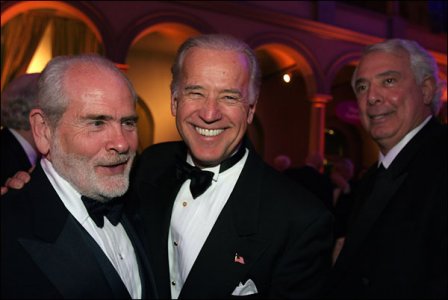
So who runs the government? Take a guess. The lobbyists fit right into this new picture, for who better to help raise money for candidates than the the lobbyists and their clients. We are now almost back to the era where corporations own their own senators and congressmen. Without big donors, a congressional career became impossible. And the congressmen themselves are almost irrelevant to the process. Legislation is written by the corporations and their lobbyists and all the congressman has to do is show up to vote. And the money flows in. There have been feeble attempts to regulate campaign financing but they have all backfired.
King Newt 
The next big change was engineered by Newt Gingrich and Tom DeLay, the all out warfare between Republicans and Democrats for control of Congress. The old collegiality was thrown out the window in favor of a fight to the death over control. Gingrich managed to wrest control of both houses of congress in 1994, largely by out-spending the Democrats for the first time in modern history. This all out warfare further crippled the ability of congress to legislate since compromise was no longer possible. DeLay, as majority whip (The Hammer) was able to exercise almost complete control over Republican members by intervening directly in campaign fund raising. A member who deviated from the party line would find his campaign funds cut off. The Republicans tried gerrymandering (redrawing district boundaries to favor one party) to make their majority permanent, and this ultimately led to the fall of Delay as he ran afoul of Texas law.
Delay Mugshot 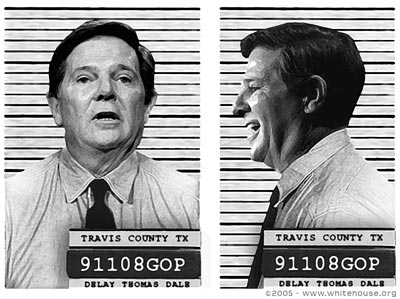
Kaiser then turns to the revolving door problem where former congressmen become lobbyists after leaving congress. Almost half of all former Senators and Congressmen now become lobbyists and running for office has become, not about public service, but mostly the career path to lobbying where big money can be made.
If the Abramoff scandal showed that lobbying tactics can go too far, so the Medicare Part D drug benefits showed that the resulting legislation can go too far in benefiting the corporate client (pharmaceuticals) to the point of outlawing competitive bidding or the foreign purchase of drugs. Strangely, Kaiser uses the drug benefit program to illustrate lawmaking gone terribly wrong, but does not list all the congressmen who left congress to join the lobbying firms immediately after passage. This was the single most blatant example of buying the votes necessary to pass bad legislation.
Kaiser’s other example of bad legislation is the bankruptcy “reform” paid for by the financial community making it impossible for bankrupt individuals to rid themselves of credit card debt, the single most frequent cause of bankruptcy after catastrophic health care costs.
Almost all the current “leading” Senators and Congressmen are cast in a bad light here for some bad legislation or another. Long gone are the statesmanlike “whales” of the LBJ era. There are no heroes in this book. So how do the people get their government back? Kaiser seems a pessimist unable to see a way to reverse these trends. And we seem to have fallen off the cliff. Can Obama reverse things? Kaiser doesn’t write about Obama and his campaign or platform. We can only hope.
